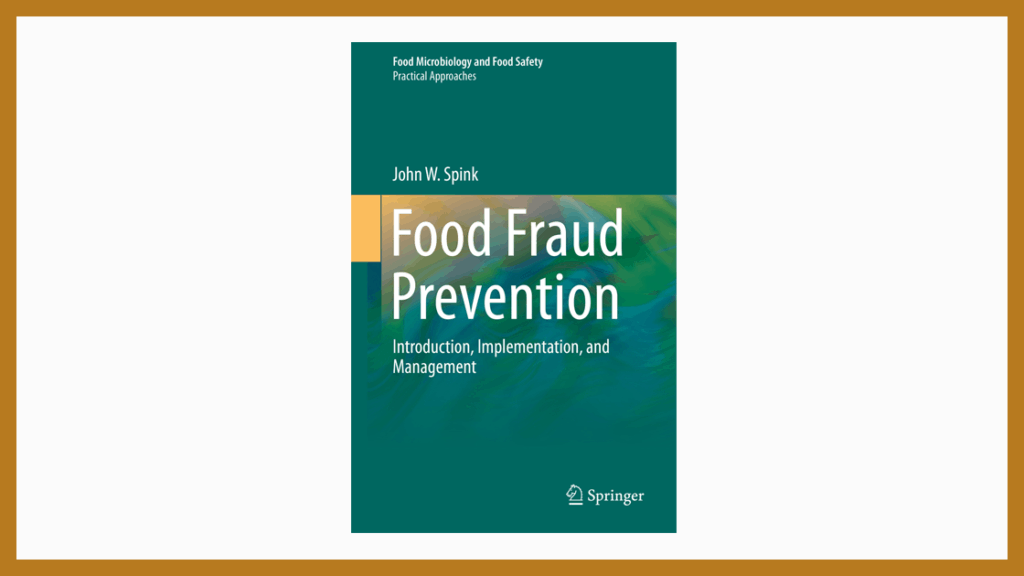Attached is an excerpt from my 2019 Food Fraud Prevention textbook that presents the consideration of fraudsters or counterfeiters as just another market competitor. To clarify, this is to consider the selection of countermeasures and control systems that reduce the business opportunity for the criminal fraudster. When considering product fraud, with the worst case that they are sociopaths and criminals, the bottom line is still the bottom line. The fraudsters are trying to make money safely. Holistically, product fraud vulnerability is reduced by increasing the risk of getting caught and/ or the cost of conducting the crime.
Link to the book publisher: https://www.springer.com/us/book/9781493996193?utm_medium=affiliate&utm_source=commission_junction_authors&utm_campaign=3_nsn6445_deeplink_PID9101220&utm_content=deeplink
Excerpt from the Food Fraud Prevention textbook:
Summary
This chapter presents an overview of the marketing, competitive strategy, and competitive intelligence concepts that apply to food fraud prevention. The fraudster is a business which makes business decisions, so they can be influenced or “dissuaded” from attacking a company, brand, or product. The fraudster should be considered a competitor alongside the traditional marketplace adversaries. This chapter will review marketing and corporate strategy concepts before laying the foundation for selecting food fraud prevention countermeasures and control systems.
The Key Learning Objectives of the chapter are:
- Competitor Analysis Overview: This is an introduction to the basics, terminology, and key theories. This is primarily based on Michael Porter’s work on corporate strategy.
- The Basic Factors in the Marketplace: To begin to analyze the market and create a decision-making method, this considers the attributes of the marketplace, consumers, and competitors.
- Scenarios that Help Define Countermeasures: Reviews of the marketplace and consumer behavior can be understood by developing models of specific product and supply chain characteristics.
Structural Entry Barrier
For food fraud prevention, the “structural entry barrier” would be the ability to produce a high-enough-quality product to deceive consumers and access to markets to sell the product (see Figure). The “expected retaliation of incumbent firms” is more than just lawsuits and government enforcement. The “expected retaliation” includes proactive changes that increase the chance of getting caught and the cost of producing the product. The response includes changing products that are hard to duplicate, tightening markets controls, and shifting buyer or consumer concerns. The entire product and sales life cycle should be reviewed for a defensive strategy to identify efficient and effective countermeasures and control systems (e.g., consider the entire beef supply chain with a concern of horsemeat). For example, there may be one key new step that undermines the ability of the fraudster to succeed (e.g., build a lab and outfit with new equipment to implement a highly effective horse species test). Also, suppose this type of highly effective countermeasure is identified. In that case, it might be proactive to go ahead and implement this across all products (e.g., use contract labs to conduct random tests on incoming beef products).

Conclusion
The product and food fraud problem is very complex and based on a wide range of issues from across the legitimate and illegitimate supply chain, and thus the response is interdisciplinary. A subset of marketing is a competitive strategy, including competitor analysis. The first conclusion is that for businesspeople who study business activities—including product and food fraud—it is logical to conduct specific studies of the patterns and responses by the adversary. For criminologists studying crime, it is logical to understand routine activity theory and rational choice theory. The logical expansion is to consider the counterfeiter as a competitor. The second conclusion is that a critical aspect of competitive strategy is to understand inherent vulnerabilities. While attacking and growing in the market, it is also essential to consider vulnerabilities and defend current positions. The logical expansion is to protect the products and prosecute the criminals and consider actions that reduce the fraud opportunity—increase the risk of getting caught or the cost of conducting the crime. The final conclusion is that theory is put into action by first considering overall strategy scenarios and building model scenarios to review specific incidents. It is efficient to consider the counterfeiter as a marketing competitor. There is a saying:
“Why not just consider the fraudster as another competitor? The logical and methodical step would be to include fraud business ‘barriers to entry’?
The field of food fraud prevention encompasses more than just the basic concepts such as arrests or detection tests. Remember, the goal is not to catch food fraud but to prevent it from occurring in the first place. The focus is on “crime prevention,” not “crime catching.” A holistic approach considers how to reduce the vulnerability most efficiently. While it may seem complex at first, inexpensive or free product design modifications can vastly reduce the fraud opportunity. Use all the resources at your disposal. Review this book chapter for more details.

